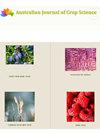磷肥效率提高影响大豆产量
Q3 Agricultural and Biological Sciences
引用次数: 0
摘要
磷肥是实现大豆高产的重要手段,特别是在磷肥效率较低的热带土壤中。聚合物包膜肥料是提高磷肥效率的几种策略之一。本研究旨在评价不同季节植物生长、叶片磷含量、大豆产量和施磷效率对施磷量和施磷源的响应。采用2 × 4 + 1因子试验,采用2种磷源(磷酸一铵(MAP)和包覆磷酸一铵(Policote-coated MAP), 4种施磷量(40、80、120和160 kg P2O5 hm -1)和对照(不施磷肥),在2016-2020季以大豆为试验材料。施磷肥能提高大豆产量,并受施磷素量和磷素来源的影响。在2017/2018、2018/2019和2019/2020季节,施用158.0、125.3和160 kg ha-1 P2O5时,MAP的大豆产量分别从未施用磷肥的1464.7 kg ha-1、468.4 kg ha-1和2297.3 kg ha-1增加到施用159.0、125.3和160 kg ha-1 P2O5时的3,638.5 kg ha-1、3,682.1 kg ha-1和3,856.7 kg ha-1,而施用Policote时,在159.0、160.0和140.1 kg ha-1 P2O5时,MAP的最大产量分别为3,950.3 kg ha-1、4,380.5 kg ha-1和4,343.0 kg ha-1。磷肥施用量的增加会降低磷素农艺利用率(APUE),磷素包覆肥(效率提高肥)可以缓解这一影响。2019/2020季APUE较低,可能是由于之前磷肥施用的残留效应本文章由计算机程序翻译,如有差异,请以英文原文为准。
Phosphorus fertilizer with increased efficiency affects soybean yields
Phosphate fertilization is an important tool for achieving high yields in soybean, especially in tropical soils where phosphate fertilization efficiency is low. Fertilizers with improved efficiency, such as polymer-coated fertilizers, are one of several strategies to increase P fertilization efficiency. The objective of this study was to evaluate plant growth, leaf P content, soybean yield, and P fertilization efficiency in different seasons in response to P rates and sources. A factorial experiment (2 x 4) + 1 using two P sources (monoammonium phosphate (MAP) and Policote-coated MAP), four P rates (40, 80, 120, and 160 kg P2O5 ha-1), and the control (no P fertilization) was conducted with soybean in the 2016-2020 seasons. Phosphate fertilization increased soybean yield and was affected by P rates and sources. Soybean yield increased from 1464.7 kg ha-1, 468.4 kg ha-1, and 2297.3 kg ha-1 without P fertilization to 3,638.5 kg ha-1, 3,682.1 kg ha-1, and 3,856.7 kg ha-1, respectively, when MAP was applied at 158.0, 125.3, and 160 kg ha-1 P2O5, while when Policote coated MAP, the maximum productivity was 3,950.3 kg ha-1, 4,380.5 kg ha-1 and 4,343.0 kg ha-1 with 159.0, 160.0 and 140.1 kg ha-1 P2O5, respectively, in 2017/2018, 2018/2019 and 2019/2020 seasons. Increasing phosphate fertilizer rates decreased agronomic P use efficiency (APUE), which was mitigated by P-coated fertilizer (fertilizer with improved efficiency). Lower APUE was observed in the 2019/2020 season, likely as a result of residual effects from previous phosphate fertilizer applications
求助全文
通过发布文献求助,成功后即可免费获取论文全文。
去求助
来源期刊

Australian Journal of Crop Science
农林科学-农艺学
CiteScore
1.20
自引率
0.00%
发文量
75
审稿时长
3.5 months
期刊介绍:
Information not localized
 求助内容:
求助内容: 应助结果提醒方式:
应助结果提醒方式:


